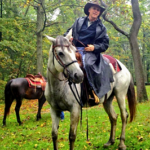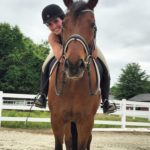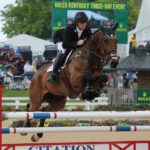To legions of horse lovers, the name Vavra brings to mind visions of flowing manes bathed in the glow of a setting sun, of flaring nostrils and fiery eyes, of horses frolicking, leaping, galloping or just standing, dignified, in a field of flowers. Robert Vavra and his camera have spent the better part of three decades circling the globe, bringing to life the archetypal horse, a creature of myth and legend.
Through a combination of vision, hard work and self-confidence, Vavra has created a virtual one-man cottage industry. His books have sold more than 3 million copies. And then there are the lucrative commissions he has garnered over the years from the likes of Max Factor, Jordache, the Franklin Mint and Delacourt Press, which requested a Vavra photograph for the cover of Nicholas Evans’ The Horse Whisperer.
“I guess I’m singular,” the photographer observes matter-of-factly. As candid as the horses he has captured on film, Vavra explains what sets him apart from other equine photographers: “When you can see the artist in the image, that’s when an image becomes art,” he says. “When people look at my images, they can say, ‘That’s a Vavra.'”
A mission to Spain
Robert Vavra was born 70 years ago in Glendale, California, near Los Angeles. Surprisingly, it was the cow, not the horse, that served as a catalyst for his career as a photographer. In 1958, inspired by the bulls and bullfighters he had seen in Mexico, the 23-year-old Vavra purchased a one-way ticket to Spain to study the native fighting bulls for a possible book. With no formal training in animal behavior, he devoted six years to the project, picking up the skills he needed along the way. “I couldn’t obtain the sort of photographs I wanted for the study, so I became a photographer out of necessity,” Vavra says.
A born raconteur, Vavra also managed to ingratiate himself with the Madrid caf? society of the time, including American movie star Ava Gardner and writers James Michener and Ernest Hemingway. Through Michener, Vavra secured his first major commission, accompanying the author on a grand tour of Spain that resulted in Michener’s 1968 treatise Iberia. Vavra’s black-and-white images-portraits, street scenes and landscapes, even a few horses-perfectly complemented the author’s ruminations. Iberia spent a year on the New York Times’ bestseller list. “That book was a tremendous boost to me,” Vavra acknowledges.
Emboldened by success and encouraged by a growing clique of famous fans, Vavra plied his craft in earnest, turning increasingly to equine subjects. There was no better laboratory for his visual experiments than southern Europe, with its photogenic Andalusians and Arabians, its stately Lusitanos and the wild gray horses of the Camargue.
Yet more than a decade would pass before Vavra would attempt to publish his equine images in a book. A Spanish stallion named Majestad helped to convince him that the time had come. “He is the only horse I ever had room for in my heart,” Vavra says.
Majestad graced the cover of Vavra’s first horse book, Equus, The Creation of a Horse, published in 1978. The stallion is shown in three-quarter profile, mane and tail glistening, standing in a field of bright-red poppies. Vavra had found his model, the prototype for all that would follow. As Michener wrote in the forward for Equus: “These photographs are works of art. They are a joy to see, because they evoke the inner nature of the horse.”
The keys to creating what the internationally known photographer himself calls “a Vavra” are choreography and composition. In practice, Vavra considers himself more a director than a photographer, and he recruits handlers and trainers to ensure that he gets exactly the shot he wants. To realize the image he has in mind, Vavra might coax a horse into position with sound cues or lure him there using another horse. Or he might map off an area with poles to guide a horse to the right spot. If a pasture is too large to be manageable, Vavra will buy temporary fencing. He’ll order trailers and other vehicles to be parked just so, ensuring that his equine subjects can’t flee.
All photographers learn to manipulate light to their advantage, and here Vavra is a master. He never uses flash or other artificial lighting, and rarely shoots in broad daylight, preferring the more dramatic effects of morning or evening light.
Vavra’s flair for chiaroscuro effects, first realized in Michener’s Iberia, remains a trademark. In his more recent work, Vavra has explored the photographic montage-multiple images superimposed or juxtaposed to achieve still more dramatic visuals. In Vavra’s Horses and Horses of the Sun, the reader beholds horses within horses, horses merged with flowers, horses that fade seamlessly into a background of autumn leaves. These are not happy accidents: The finished product is already in his head before he shoots, Vavra insists; all that remains is to produce the constituent images.
A self-confessed “stone age” man, Vavra regards the computer as a regrettable necessity for today’s photographer. His cover for the bestseller The Horse Whisperer is a computer-manipulated composite of three separate images, and Horses of the Sun includes a credit for a digital-imaging company. Vavra makes these concessions to the state of the art reluctantly:
“The computer is the end of nature photography,” he declares. “I have to go with it, but I don’t like it.”
For that matter, Vavra admits to a certain indifference toward the f-stops, shutter speeds and other minutiae of the trade. The camera, to Vavra, is merely a means to an end. “I’ve never been interested in the camera,” he says.” I don’t really consider myself a photographer. I’m an artist and a storyteller.”
This article is excerpted with permission from “Vavra’s Vision,” published in EQUUS 241, the November 1997 issue.







